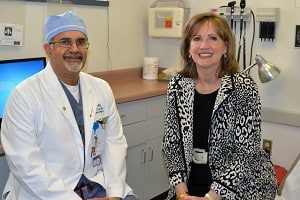Varicose Vein Treatment Gives Educator Extra Pep
| When many people think of varicose veins, images of enlarged and bulging vessels visible through the skin come to mind. While that is often a telltale sign of the condition, varicose veins can sometimes exist deeper beneath the skin’s surface.

Former UAMS College of Nursing Dean Lorraine Frazier speaks with vascular surgeon Ahsan Ali, M.D., following her treatment for varicose veins.
“I didn’t have the typical symptoms,” said Lorraine Frazier, Ph.D., R.N., former dean of the UAMS College of Nursing. “You wouldn’t look at my legs and think, ‘Oh. She has varicose veins.’”
What caught Frazier’s attention was a sore on her leg that wouldn’t heal well. She went to her dermatologist who sent her to the vascular clinic to make sure her circulation was good. A diagnostic test confirmed Frazier did have varicose veins.
“It didn’t surprise me because my mother had three surgeries on veins in her legs in her 40s,” Frazier said. “I knew it could be hereditary.”
Frazier says her legs would ache at night – but it was never very painful. She attributed the feeling to fatigue after having worked a long day.
“There is a wide range of intensity of how varicose veins affect someone,” said Ahsan Ali, M.D., vascular surgeon and a professor in the Department of Surgery in the UAMS College of Medicine. “It can cause anything from dull pain and achiness to ulcers.”
Varicose veins can happen anywhere in the body. But they are most common in the legs. Veins have cup-like valves that open to allow blood through and then close to prevent backflow. In varicose veins, the valves do not work properly causing the blood to pool in the vein creating a bulge.
“A good number of patients do not have any visible bulging,” Ali said. “They have little to no symptoms and sometimes it goes unrecognized.”
Patients may just feel a dull ache and consider it part of getting tired at the end of the day. Frazier says she may have had the tired, achy feeling about eight years.
“It wasn’t painful,” she said. “But now that I’ve had treatment, I do feel much better.”
She first realized a significant difference while taking a long walk with her husband in downtown Little Rock. “We were walking across one of the pedestrian bridges,” she said. “When we finished I noticed how good I felt. I would normally be tired after such a long walk. This time, I felt I could go again. It was pretty amazing. That’s when I realized that there had to be something wrong with my circulation before my treatment.”
Frazier felt that it was important for others to know that just because you don’t see bulging veins doesn’t mean you might not have varicose veins.
“I got on the phone and called my sister,” Frazier said. “I said, ‘You need to get your legs checked out.’ She did. And she had the exact same issue. And she’s an athlete so it was a little surprising.”
Approximately 25 million people in the United States have varicose veins. It’s much more common in women than in men. Ali says the screening process for detecting varicose veins is simple and non-invasive. It includes an ultrasound.
“Once the diagnosis is made, we give the patient compression stockings,” Ali said. “They are prescription-strength and the patient will wear them for three to six months to decrease pressure in the veins.”
Once that time period is over, Ali says he’ll see the patient again. If the problem persists, there are other options for treatment including radiofrequency ablation, a procedure that uses heat to close the vein from the inside. It’s done by inserting a heated catheter, a thin tube, into the length of the vein. As the catheter is pulled out, the heat collapses the vein and seals it shut.
Ali says treatment for varicose veins are outpatient procedures and patients often see improvements within days of their surgery.
“If someone is concerned about achiness in their veins or even worried about it cosmetically, they should get screened,” Ali said.
Ali said people sometimes confuse spider veins as being varicose veins. Spider veins are rarely a serious health problem. They resemble a spider’s web and are often much smaller than varicose veins.
Frazier says she’s more conscious about taking care of her legs even now that she’s had the treatment.
“We use our legs all the time and sometimes we don’t think about it,” Frazier said. “I’m so used to feeling good now. Everyone should feel that way. You owe it to yourself to feel your best in life.”